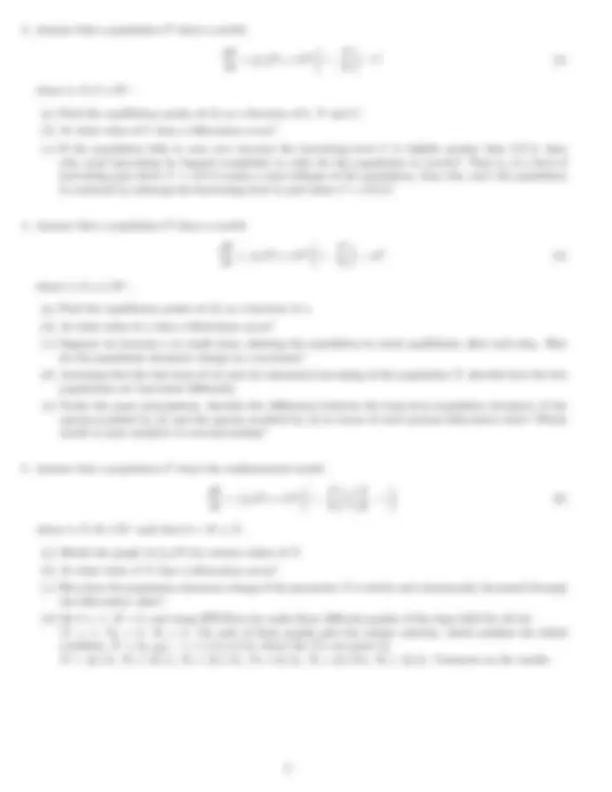



Study with the several resources on Docsity

Earn points by helping other students or get them with a premium plan


Prepare for your exams
Study with the several resources on Docsity

Earn points to download
Earn points by helping other students or get them with a premium plan
Community
Ask the community for help and clear up your study doubts
Discover the best universities in your country according to Docsity users
Free resources
Download our free guides on studying techniques, anxiety management strategies, and thesis advice from Docsity tutors
A university homework assignment for math 235 - differential equations with honors, focusing on existence and uniqueness, phase lines, bifurcations, and logistic growth. Students are asked to sketch slope fields, describe long-term behavior, and classify equilibrium solutions for various odes. Additionally, they must analyze the qualitative changes in long-term behavior as parameters vary.
Typology: Assignments
1 / 2

This page cannot be seen from the preview
Don't miss anything!


MATH 235 - Differential Equations w/ Honors January 28, 2008 Homework 3, Spring 2008 Due: February 6, 2008 Existence and Uniqueness - Phase Lines - Bifurcations - Logistics Growth
6
f 1 (y)
y
6
f 2 (y)
y
6
f 3 (y)
y
(a) On separate graphs, roughly sketch the slope fields associated with dy dt
= fi(y), i = 1, 2 , 3.
(b) Assuming that both f and ∂f ∂yi , i = 1, 2 , 3, are continuous for all (t, y) in the ty-plane, describe the long term behavior of the solution satisfying the initial condition, y(0) = y?, for each of the three ODE’s. (c) Sketch a phase line for each differential equation and classify the equilibrium solutions. (d) Assuming that y > 0, describe the qualitative changes to the long term behavior of possible solutions to each system as i varries from one to three.
dy dt
= −y^2 (1)
y 1 (t) = 1 t − 1
y 2 (t) =
t − 2 (3) (a) Show that y 1 (t) and y 2 (t) are solutions to (1). (b) Show that (1) satisfies the existence and uniqueness theorem for all points in the ty-plane. (c) On the same axes graph both y 1 and y 2 for t > 0. (d) Assume that y(t) is a solution to (1), which satisfies − 1 < y(0) < − 1 /2. What can be said of this solution for t > 0? What about the solution satisfying, − 1 / 2 < y(3/2) < 2, or the one satisfying, 1/ 2 < y(3) < 1 for t > 0?
dP dt
= fC (P ) = kP
where k, N, C ∈ R+.
(a) Find the equilibrium points of (4) as a function of k, N and C. (b) At what value of C does a bifurcation occur? (c) If the population falls to near zero because the harvesting level C is slightly greater than kN/4, then why must harvesting be banned completely in order for the population to recover? That is, if a level of harvesting just above C = kN/4 causes a near-collapse of the population, then why can’t the population be restored by reducing the harvesting level to just below C = kN/4?
dP dt =^ fα(P^ ) =^ kP
− αP (5)
where k, N, α ∈ R+. (a) Find the equilibrium points of (5) as a function of α. (b) At what value of α does a bifurcation occur? (c) Suppose we increase α in small steps, allowing the population to reach equilibrium after each step. How do the population dynamics change as α increases? (d) Assuming that the last term of (4) and (5) represents harvesting of the population P , describe how the two populations are harvested differently. (e) Under the same assumptions, describe the differences between the long term population dynamics of the species modeled by (4) and the species modeled by (5) in terms of each systems bifurcation value? Which model is more sensitive to over-harvesting?
dP dt
= fN (P ) = kP
where k, N, M ∈ R+^ such that 0 < M ≤ N.
(a) Sketch the graph of fN (P ) for various values of N. (b) At what value of N does a bifurcation occur? (c) How does the population dynamics change if the parameter N is slowly and continuously decreased through the bifurcation value? (d) Set k = 1, M = 2, and using HPGSolver make three different graphs of the slope field for (6) for N 1 = 1, N 2 = 2, N 3 = 3. On each of these graphs plot the unique solution, which satisfies the initial condition, Pi = (t 0 , y 0 ), i = 1, 2 , 3 , 4 , 5 , 6, where the Pi’s are given by P 1 = (0, .5), P 2 = (0, 1), P 3 = (0, 1 .5), P 4 = (0, 2), P 5 = (0, 2 .5), P 6 = (0, 3). Comment on the results.